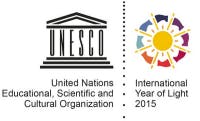Final report from the International Year of Light points toward photonics policy and education needs
The official final report on the UN’s International Year of Light and Light-based Technologies in 2015 (IYL2015) was delivered to UNESCO's Assistant Director-General for Natural Sciences, Flavia Schlegel, on October 3. The ability to make further progress depends as much on government policy as scientific innovation--and the ability to overcome communication and value gaps that separate them, noted SPIE CEO Eugene Arthurs.
Such communication is critical if global Sustainable Development Goals (SDGs) established by the United Nations are to be met, according to Arthurs, who was speaking at the UNESCO headquarters in Paris. He added that politicians need to understand the importance of light-based technologies to the safety and well-being of citizens, and the photonics community needs to keep sharing this message including updates as new capabilities are developed.
Flavia Schlegel said the IYL2015 report was "the best final report that I have seen so far ... many congratulations to the many consortia partners who made this year possible." She noted that the observance had included 13,168 events in 147 countries.
In her remarks, Ana María Cetto of the Instituto de Física, UNAM, and director of the Museum of Light, México, advocated for a designated Day of Light on 16 May, the anniversary of the first successful firing of a laser. During IYL2015, she said, “many activities were established that should not stop.” Establishing a Day of Light could create new opportunities to continue to work together.
“The IYL2015 has provided a timely reminder that through our commitment to education and outreach, we can really make a difference,” said John Dudley, Chair of the IYL015 Steering Committee. “It is now up to us to build on what we have learned and what we have accomplished during 2015 to continue to work together for the betterment of all.”
The final report may be downloaded from this page: http://www.light2015.org/Home/About/IYL-Final-Report.html (PDF 40 MB).
Source: SPIE

Conard Holton
Conard Holton has 25 years of science and technology editing and writing experience. He was formerly a staff member and consultant for government agencies such as the New York State Energy Research and Development Authority and the International Atomic Energy Agency, and engineering companies such as Bechtel. He joined Laser Focus World in 1997 as senior editor, becoming editor in chief of WDM Solutions, which he founded in 1999. In 2003 he joined Vision Systems Design as editor in chief, while continuing as contributing editor at Laser Focus World. Conard became editor in chief of Laser Focus World in August 2011, a role in which he served through August 2018. He then served as Editor at Large for Laser Focus World and Co-Chair of the Lasers & Photonics Marketplace Seminar from August 2018 through January 2022. He received his B.A. from the University of Pennsylvania, with additional studies at the Colorado School of Mines and Medill School of Journalism at Northwestern University.
